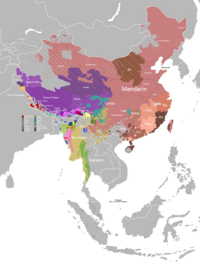mDungnag language
| mDungnag Tibetan | |
|---|---|
| Dongna | |
| Native to | China |
| Region | Gansu |
| Language codes | |
| ISO 639-3 | None (mis) |
| Glottolog | None |
mDungnag Tibetan (or mDung-nag; also known as Dongna 东纳话[1]) is a divergent Tibetic language of western Gansu, China.[2]
Distribution
[edit]mDungnag is spoken in Qifeng Tibetan Ethnic Township (祁丰藏族乡), Sunan Yugur Autonomous County, Gansu, China.[1]
Classification
[edit]Shao (2018) notes that mDungnag is not mutually intelligible with either Khams Tibetan or Amdo Tibetan. It may possibly be a divergent form of Amdo Tibetan due to some shared vocabulary, although these similarities could also be due to contact. The exact classification of mDungnag within Tibetic remains uncertain.[1]
Phonology
[edit]mDungnag is a non-tonal language.[1]
Dialects
[edit]mDungnag can be divided into two dialects:[1]
- Hexi 河西 ("West River"): spoken in Baozitan Village 堡子滩村
- Hedong 河东 ("East River"): spoken in Qingkedi Village 青稞地村 and Ciyaokou 瓷窑口村 Village. This is the dialect that is primarily documented in Shao (2018).
Some lexical differences between the Hexi and Hedong dialects include the following. Translated English glosses have also been provided to supplement the original Chinese glosses from Shao (2018).[1]
| Chinese gloss | English gloss | Hexi | Hedong |
|---|---|---|---|
| 乌鸦 | crow (bird) | kʰɐtʰɐ | hɐtʰɐ |
| 黄羊 | Mongolian gazelle | ʱgʷɐ | ʱgo |
| 旱獭 | marmot | ʂʮ | ʂʷa |
| 开水 | boiling water | tʂʰənkʰo | tʂʰəkʰo |
| 大坂 | large mountain | lʷɐ | lɐ |
| 红嘴鸦 | Red-billed chough | ʰtʂoŋχʷa | ʰtʂoŋhɐ |
| 馒头 | mantou (steamed bun) | kɔrɐ | kʷɐrɐ |
| 骆驼 | camel | ʱŋɐmaŋ | ʱŋɐməŋ |
| 白胸黑狗 | white-chested black dog | taŋkʰar | taŋɣar |
| 踩 | to step on | ʱdə | ʱdi |
| 耕地 | to plow, till | ʰtʂɐk | ʱmi (perfective; imperative); ʱmɔ (imperfective) |
| 穿 | to wear | kon | kʷan |
| 骑 | to ride | ʂon | ʂʷan |
| 点火 | to ignite, light (fire) | ʱdʑon | ʱdʑʷan |
| 吵 | to quarrel | kʰon | kʰʷan |
| 使役/使用 | to use | kʰɔ | ko |
| 疼痛 | pain | ʱdzer | zer |
| 舀 | to scoop | ʰtʂʷi (perfective; imperative); tʂʮ (imperfective) | sʷi (perfective; imperative); sʮ (imperfective) |
| 数字连词 | numeral affix | sɔ | ʰtsɐ |
| 棉袄 | cotton jacket | tʂyɣɔtsə | orə |
| 杏子 | apricot | ɣorək | xaŋrə |
| 山羊羔子 | kid (of mountain goat) | eᶳtsə | rəᶳtsə |
| 帽子 | hat | ⁿgɔʂɐ | kɐli |
| 两口子 | married couple | ʱdzɐwɐ | ʱdzɐⁿgɔ |
| 头面 | face; woman's head ornaments | ʰtəkgʷɔ | ʰtəkdʑap |
References
[edit]- ^ a b c d e f Shao, Mingyuan 邵明园 (2018). Hexi Zoulang binwei Zangyu Dongnahua yanjiu 河西走廊濒危藏语东纳话研究 [Study on the mDungnag dialect, an endangered Tibetan language in Hexi Corridor]. Guangzhou: Zhongshan University Publishing House 中山大学出版社.
- ^ 鈴木, 博之 Hiroyuki Suzuki (2019). "書評:邵明園(著)《河西走廊瀕危藏語東納話研究》慶州". 京都大学言語学研究 Kyoto University Linguistic Research. 38. Kyoto: 京都大学言語学研究室: 65–73. doi:10.14989/250192.
